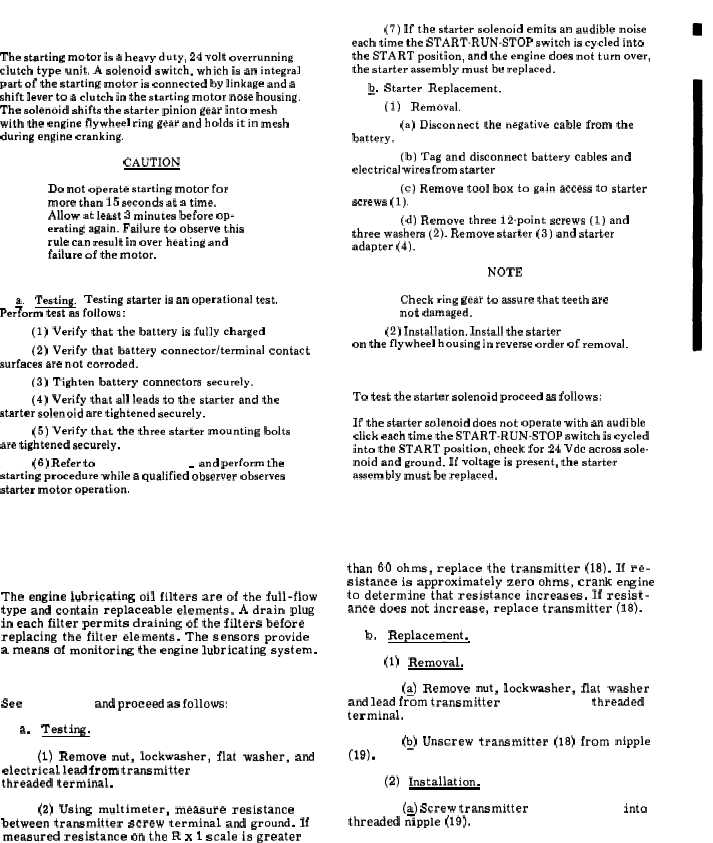T M
5 - 6 1 1 5 - 5 4 5 - 1 2
T O - 3 5 C 2 - 3 - 4 4 4 - 1
N A V F A C
P - 8 - 6 2 6 - 1 2
T M - 0 0 0 3 8 G - 1 2
S e c t i o n
X X X I .
E L E C T R I C
S T A R T E R
A N D
A D A P T E R
3 - 1 8 9 . G e n e r a l .
The starting motor is a heavy duty, 24 volt overrunning
clutch type unit. A solenoid switch, which is an integral
part of the starting motor is connected by linkage and a
shift lever to a clutch in the starting motor nose housing.
The solenoid shifts the starter pinion gear into mesh
with the engine flywheel ring gear and holds it in mesh
during engine cranking.
CAUTION
Do not operate starting motor for
more than 15 seconds at a time.
Allow at least 3 minutes before op-
erating again. Failure to observe this
rule can result in over heating and
failure of the motor.
3 - 1 9 0 . S t a r t e r A s s e m b l y .
~.
Testing.
Testing starter is an operational test.
Perform test as follows:
(1) Verify that the battery is fully charged
(2) Verify that battery connector/terminal
contact
surfaces are not corroded.
(3) Tighten battery connectors securely.
(4) Verify that all leads to the starter and the
starter solenoid are tightened securely.
(5) Verify that the three starter mounting bolts
are tightened securely.
(6) Refer to p a r a g r a p h 2 - 1 2 b and perform the
starting procedure while a qualified observer observes
starter motor operation.
(7) If the starter solenoid emits an audible noise
each time the START-RUN-STOP switch is cycled into
the START position, and the engine does not turn over,
the starter assembly must be replaced.
b. Starter Replacement.
—
(1)
Removal.
(a) Disconnect the negative cable from the
battery.
(b) Tag and disconnect battery cables and
electrical wires from starter ( 3 , f i g . 3 - 3 8 . 1 ) .
(c) Remove tool box to gain access to starter
screws (l).
(d) Remove three 12-point screws (1) and
three washers (2). Remove starter (3) and starter
adapter (4).
NOTE
Check ring gear to assure that teeth are
not damaged.
(2) Installation. Install the starter ( 3 , f i g . 3 - 3 8 . 1 )
on the flywheel housing in reverse order of removal.
3 - 1 9 1 .
S t a r t e r
S o l e n o i d .
To test the starter solenoid proceed as follows:
If the starter solenoid does not operate with an audible
click each time the START-RUN-STOP switch is cycled
into the START position, check for 24 Vdc across sole-
noid and ground. If voltage is present, the starter
assembly must be replaced.
S e c t i o n X X X I I . L U B E O I L F I L T E R S A N D S E N S O R S
3 - 1 9 2 .
G e n e r a l .
The engine lubricating oil filters are of the full-flow
type and contain replaceable elements. A drain plug
in each filter permits draining of the filters before
replacing the filter elements. The sensors provide
a means of monitoring the engine lubricating system.
3 - 1 9 3 . O i l P r e s s u r e T r a n s m i t t e r .
See f i g u r e 3 - 3 and proceed as follows:
a.
Testing.
(1) Remove nut, lockwasher, flat washer, and
electrical lead from transmitter ( 1 8 , f i g . 3 - 3 )
threaded terminal.
(2) Using multimeter, measure resistance
between transmitter screw terminal and ground. If
measured resistance on the R x 1 scale is greater
than 60 ohms, replace the transmitter (18). If re-
sistance is approximately zero ohms, crank engine
to determine that resistance increases. If resist-
ance does not increase, replace transmitter (18).
b.
Replacement.
(1)
Removal.
(~) Remove nut, lockwasher, flat washer
and lead from transmitter ( 1 8 , f i g . 3 - 3 ) threaded
terminal.
(~) Unscrew transmitter (18) from nipple
(19).
(2)
Installation.
(a) Screw transmitter ( 1 8 , f i g . 3 - 3 ) into
threaded fipple (19).
C h a n g e 1 3
3 - 9 3

